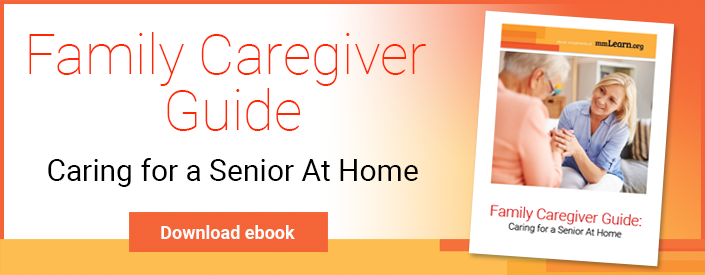 The first thing to know about heart failure is that it is not a failure—on the part of the patient, the doctors, or the family caregiver.
The first thing to know about heart failure is that it is not a failure—on the part of the patient, the doctors, or the family caregiver.
The heart is still working, just not as well as it could be.
Living with heart failure is a challenge, but many seniors (and some younger folks) are doing it.
With the right medical care, a firm knowledge base, and excellent caregiving, heart failure is a manageable condition.
What Heart Failure Is—and Isn’t
In our 4-part video series Living with Heart Failure, Beverly Tuomala, a Heart Failure Nurse Specialist, BSN, RN, CHFN, introduces the audience to the basics of heart failure. The videos cover the following topics.
- Part 1: Identifying the Problem
- Part 2: Medications and Therapies
- Part 3: Sodium/Fluid Restriction
- Part 4: Putting It All Together
It’s important to distinguish heart failure from congestive heart failure. Congestive heart failure is a much more serious type of heart failure that requires immediate medical attention.
How do you know if you or a loved one is at risk of experiencing heart failure?
How Is Heart Disease Diagnosed?
Most often, someone will arrive at the emergency room experiencing shortness of breath and edema (swelling).
A chest X-ray will show that the heart is enlarged, giving the doctors a clue to run further tests.
If the doctors suspect heart failure, they will likely schedule one or more of the following tests:
- An echocardiogram
- Nuclear scans (stress test)
- Cardiac cath (a test where dye is injected into the pumping chamber of the heart so doctors can actually see the heart moving and pumping).
All these tests are trying to determine how much blood is leaving the heart with each pump. They are looking for a percentage called the ejection fraction (EF), an estimate of how much blood leaves the heart with each pump.
A normal heart has an EF of 50% or more.
Heart Function
Hearts truly are pumps. Their job is to pump oxygen and blood to the cells of the body. The cells are then nourished, and the body can function normally.
When we don’t get enough oxygen or blood, it becomes difficult to perform everyday activities.
That leads to the feeling that everything is too tiring. So the heart starts working harder by doing things like pumping faster, getting bigger, and developing more muscle mass. Blood vessels narrow and start taking resources away from other organs.
Hearts work by squeezing and then relaxing. A problem with either of those actions can mean heart failure.
What Is Heart Failure?
Heart failure is more than a mechanical problem. When the body doesn’t get enough oxygen-rich blood, it causes activation of the neuroendocrine system, releasing stress hormones.
The neurohormones have several negative effects. They constrict arteries, and they retain salt and water, so fluid builds up in the tight blood vessels. This creates a vicious cycle because the person feels thirsty and drinks more. The heart keeps working harder and harder, making the symptoms worse.
There are two main types of heart failure.
- Systolic heart failure means the heart has a weak pump, with a strength of less than 50%.
- Diastolic heart failure (also called heart failure with preserved ejection fraction) means the heart isn’t relaxing enough between pumps to fill it with enough blood. A stiff muscle does not relax for good filling. Heart strength may be normal or high.
How do you know if either one of these types of heart failure is a problem for someone you know?
Symptoms of Heart Failure
It’s important to be alert, especially as people age, to the symptoms of heart failure. The following are warning signs:
- Sudden weight gain, such as 3–4 pounds in 1–2 days, or 5 pounds in a week
- Swelling of legs/ankles
- Swelling/bloating/pain in abdomen
- Loss of appetite, feeling full earlier
- Trouble lying down, needing two or more pillows (orthopnea)
- Shortness of breath—PND
- Frequent dry, hacking cough (gasping for air)
- Fatigue with very little effort (it’s like carrying around a 20-pound bag of flour every day)
If any of these things are happening, don’t wait to talk to your doctor. It’s important to figure out what’s going on in there as soon as possible.
How Common Is Heart Failure?
Heart failure usually develops in older people when they have another heart condition: high blood pressure, coronary artery disease, or previous heart attacks.
Lots of people are living with heart failure. The American Heart Association website reports that more than 6 million people are living with heart failure, and about 10% of those have advanced heart failure.
Advanced heart failure means the person has trouble catching their breath even when they are resting.
In early stages of heart failure, the condition can be managed through medication and lifestyle changes: exercise and a healthy diet.
Tips for Managing Heart Failure
- Get weighed every day. A sudden weight gain is a sign the kidneys are holding salt and water in the body. One of the best ways to keep track of this is to get in the habit of stepping on a scale every single day. It’s best to do it in the morning after urination and before eating or getting dressed. Keep a log so you can notice patterns. And call a doctor if you gain 3–4 pounds in 1–2 days or 5 pounds in a week. The weight gain is fluid, not solid, so people often feel bloated and have less appetite.
- Take note of changes in swelling and activity levels. As heart disease worsens, it becomes harder and harder to sleep and go about your daily activities.
- Quit smoking. Smoking increases your heart rate and blood pressure, and it interferes with blood flow.
- Eat healthy foods and maintain a healthy weight. Learn to read food labels to identify high-sodium foods (more than 350 mg/serving). We love these suggestions for healthy substitutions from the American Heart Association:
- Instead of ice cream, try guacamole or avocado on whole grain bread or creamy peanut butter or fresh berries on yogurt.
- Instead of pretzels or chips, experiment with crunchy unsalted nuts, whole grain cereal, whole grain crispbreads, or popcorn spiced with your favorite herbs.
- Choose crispy varieties of apples like Braeburn, Honeycrisp, Fuji, and Gala instead of softer ones like Red Delicious. Same goes for potatoes. Red or yellow potatoes are less mealy than Russets. - Eat a potassium-rich diet. Dried fruits, fresh fruits and vegetables, dried vegetables, fresh and canned juices, and salt substitutes.
- Develop a clear plan for treatment. Develop a roadmap with caregiver, patient, and doctor where everyone can discuss options, risks, and treatments. This includes developing an end-of-life plan that makes sure that the patient’s wishes are being met.
Medications and Therapies for Heart Failure
There are four types of medications that are used most commonly to treat heart failure.
- Diuretics (or water pills) to help the kidneys make more urine so the patient can urinate more get rid of the extra water
- ACE inhibitors and ARBs to relax the blood vessels and make the heart’s job easier
- Beta-blockers to ease the heart’s workload and remodel its behavior
- Digoxin to control the heart rate and symptoms
- Potassium replacement (supplements) like K-Dur, Micro-K+, KCL, and potassium-sparing diuretics
Understanding Sodium/Fluid Restriction
Everyone who is diagnosed with heart failure should be instructed to restrict sodium in their diet. The kidneys can no longer regulate salt and water; they retain it instead.
Americans are a salty bunch. Here are some numbers that might give you pause.
- The average American consumes between 4,000 and 10,000 mg of sodium each day.
- Heart failure patients are restricted to 2,000 mg per day. So that’s less than half of the lowest end of the spectrum.
Salt is everywhere. And as we get older, the taste buds lose some oomph, so older people tend to salt their food even more. Fast foods, frozen foods, and convenience foods are laden with salt.
Caregivers can help with sodium restriction. Everyone who is involved in shopping, cooking, and eating should understand the importance of limiting sodium intake and finding creative solutions to make sure the food is still delicious. Completely eliminating salt from cooking is challenging because we are used to salty foods. But it helps to eat lots of fresh or frozen vegetables and to season with fresh/dried herbs, vegetables, or no-salt seasonings.
When eating out, it’s best to order foods cooked without breading, butter, or sauces, or to ask for food to be cooked without salt. Avoid soups, and watch salad dressings. When people who have heart failure weigh themselves every day, they can detect sudden weight gain and avoid restaurants that contributed to it.
It might seem hard, but people can and do get accustomed to low-sodium diets.
Working Together for a Healthier Life
Heart failure is a serious matter, and compliance with medications and lifestyle changes is a challenge for a lot of people.
Caregivers can help. In the video on Putting It All Together, Tuomala shares 4 tips for improving compliance:
- Encourage patients to have a written schedule and to use a pill tray to keep track of medications. A great resource for keeping track of all the moving parts is medactionplan.com.
- Take diuretics in the morning and mid-afternoon. People sleep better if they don’t have to go to the bathroom as often during the night.
- Report any symptoms or side effects to the doctor.
- Don’t stop medications, even if patients feel better.

